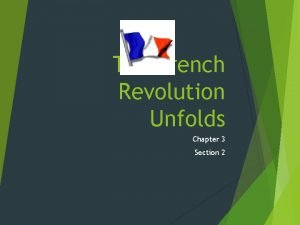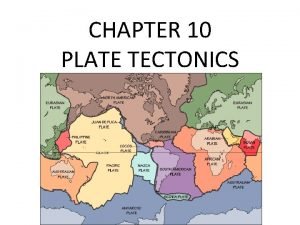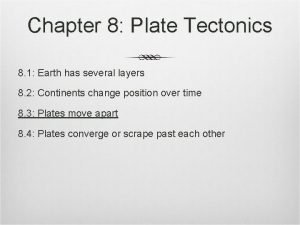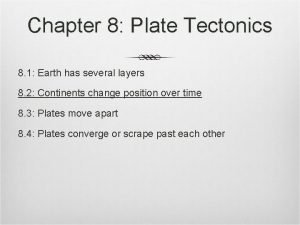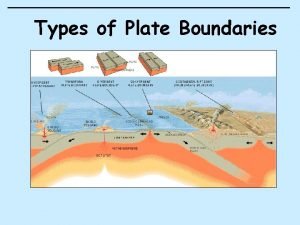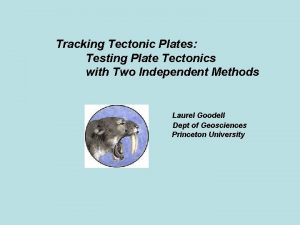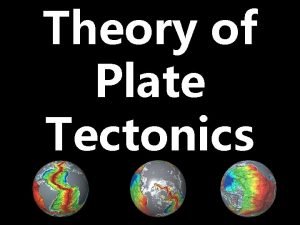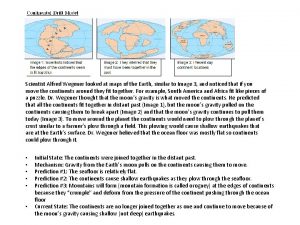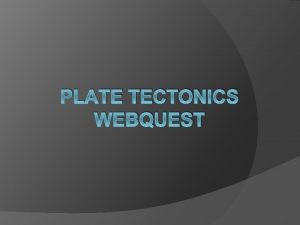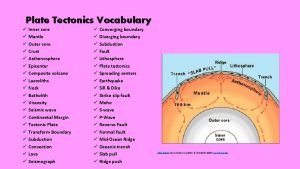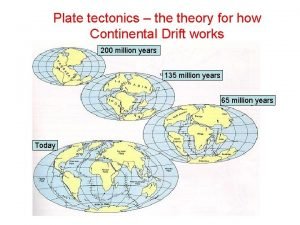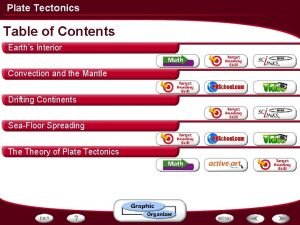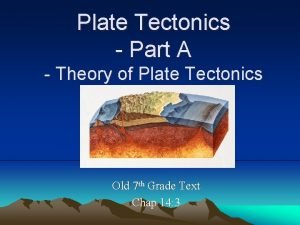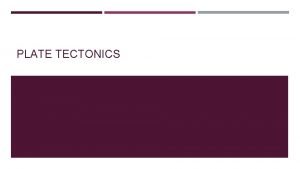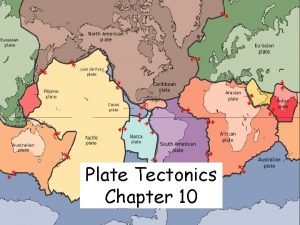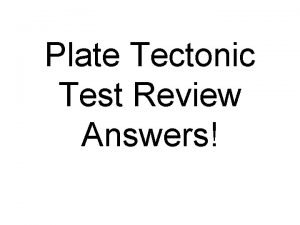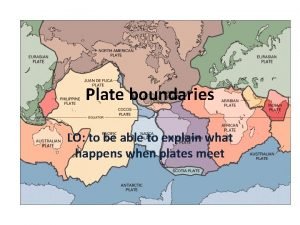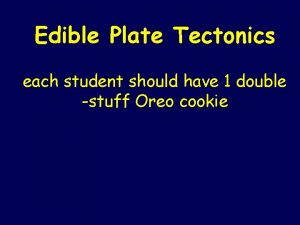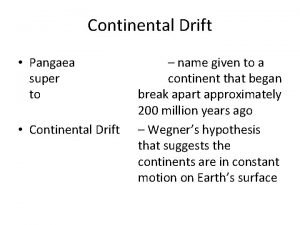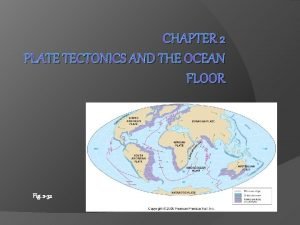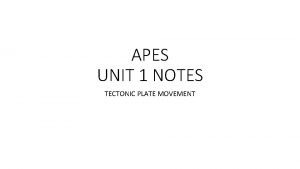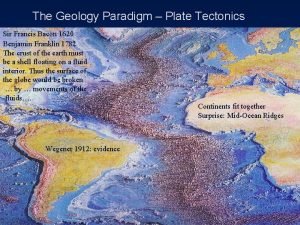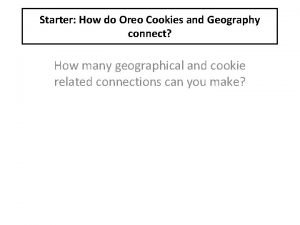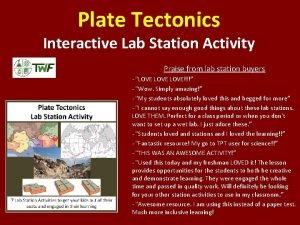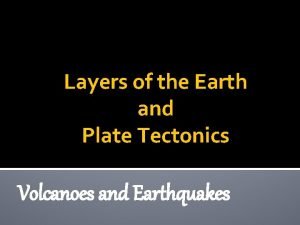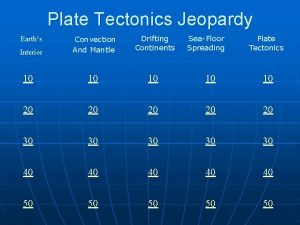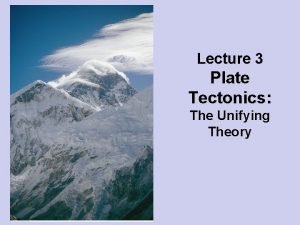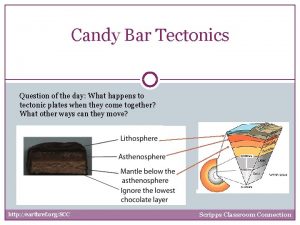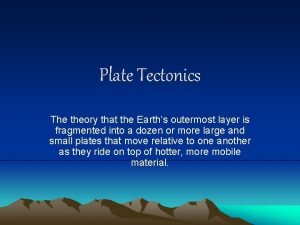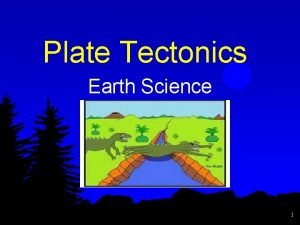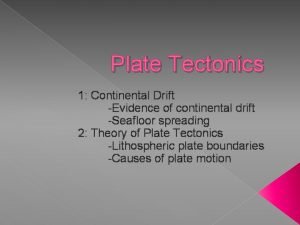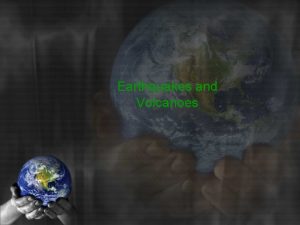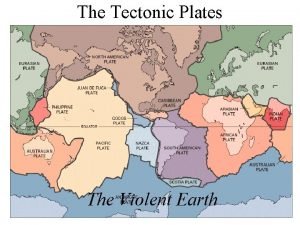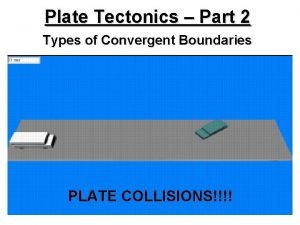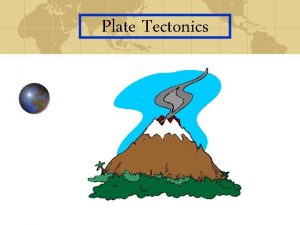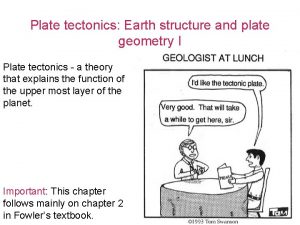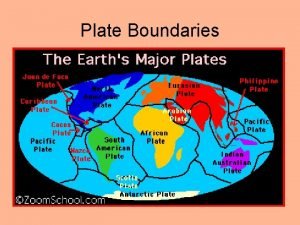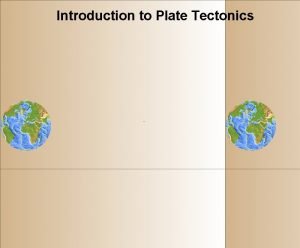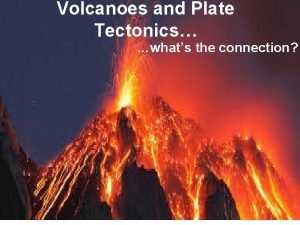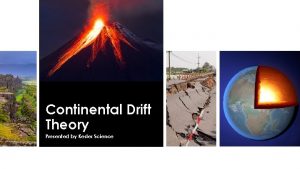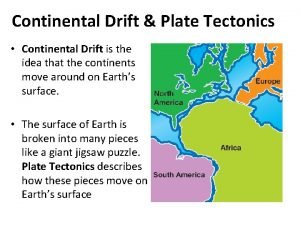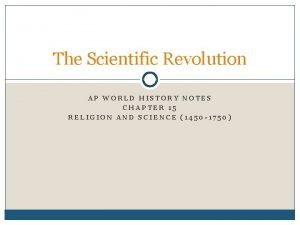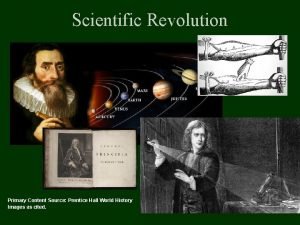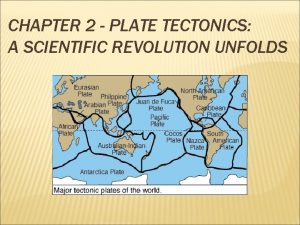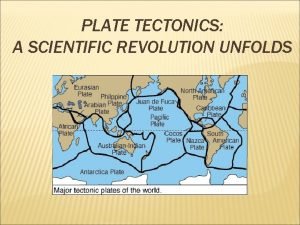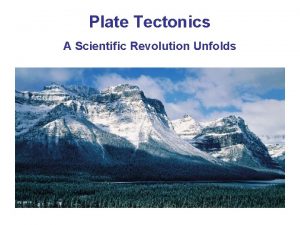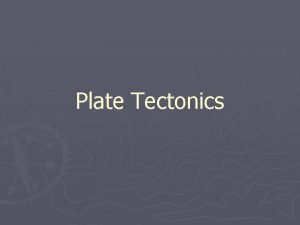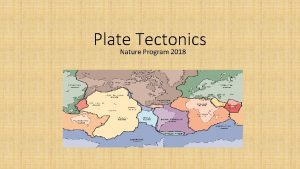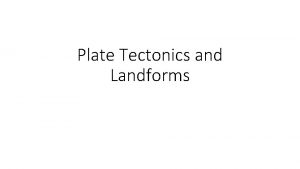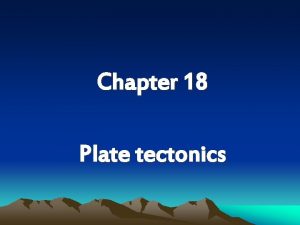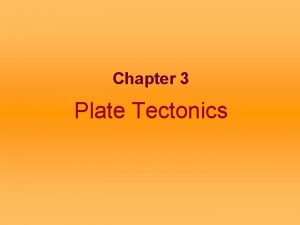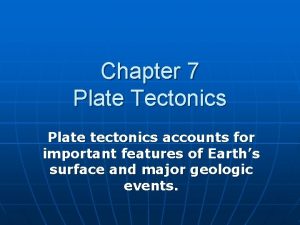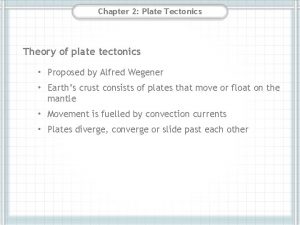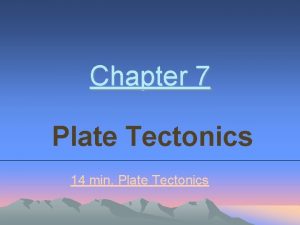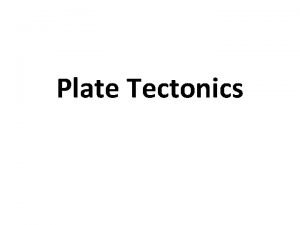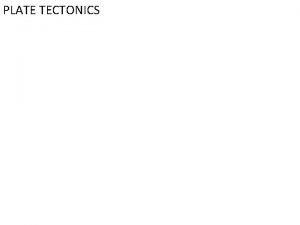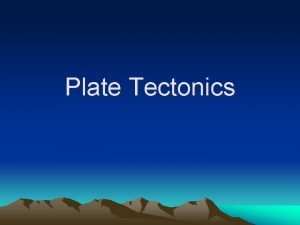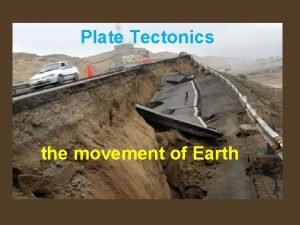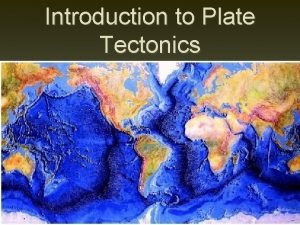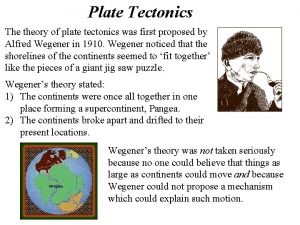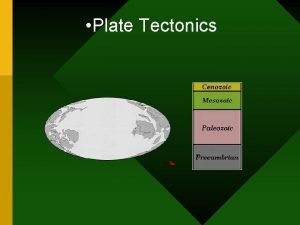Plate Tectonics A Scientific Revolution Unfolds Chapter 2




























































- Slides: 60

Plate Tectonics A Scientific Revolution Unfolds

Chapter 2 – Plate Tectonics © 2009 -2018 Phil Farquharson, “Geology Guy”

From Continental Drift to Plate Tectonics • Prior to the late 1960 s, most geologists believed that the positions of the continents and ocean basins were fixed. • Continental drift, a hypothesis that challenged this belief, was first proposed in 1915. • In the late 1960 s, scientific developments led to the unfolding of theory of plate tectonics. © 2017 Pearson Education, Inc.

Continental Drift: An Idea Before Its Time • Alfred Wegener – First proposed continental drift hypothesis in 1915 – Published The Origin of Continents and Oceans • Continental drift hypothesis – A supercontinent, consisting of all of Earth’s landmasses, once existed – During the Mesozoic, about 200 million years ago, this supercontinent began fragmenting – Wegener named the supercontinent Pangaea, meaning “all lands” © 2017 Pearson Education, Inc.

Reconstructions of Pangaea © 2017 Pearson Education, Inc.

Continental Drift: Supporting Evidence • The Continental Jigsaw puzzle © 2017 Pearson Education, Inc.

Continental Drift: Supporting Evidence • Fossils Matching Across the Seas – Identical fossil organisms are found on continents now separated by vast oceans. © 2017 Pearson Education, Inc.

Continental Drift: Supporting Evidence • Rock Types and Geologic Features – Matching mountain ranges across the Atlantic © 2017 Pearson Education, Inc.

Continental Drift: Supporting Evidence • Ancient climates – Locations of ancient ice sheets and coal swamps © 2017 Pearson Education, Inc.

The Great Debate • Objections to the continental drift hypothesis: – Wegener’s inability to identify a credible mechanism for continental drift • Incorrectly proposed the gravitational forces of the Moon and Sun were capable of moving the continents. • Incorrectly suggested that continents broke through the ocean crust like icebreakers. – There was strong opposition to this hypothesis from all areas of the scientific community, and it was rejected. © 2017 Pearson Education, Inc.

The Theory of Plate Tectonics • Following World War II, oceanographers with new equipment explored the seafloor – Oceanic ridge system winds through all of the major oceans – No oceanic crust older than 180 million years old – Thin sediment accumulation in the deep oceans • These developments and others led to theory of plate tectonics. © 2017 Pearson Education, Inc.

The Theory of Plate Tectonics • Rigid Lithosphere Overlies Weak Asthenosphere – The lithosphere is Earth’s strong, outer layer. – The asthenosphere is a hotter, weaker region of the mantle under the lithosphere. – Because of the differences in physical properties, the lithosphere is effectively detached from the asthenosphere, allowing layers to move separately. © 2017 Pearson Education, Inc.

The Theory of Plate Tectonics • Earth’s Major Plates – The lithosphere is broken into approximately two dozen smaller sections called lithospheric plates. – These plates are in constant motion. © 2017 Pearson Education, Inc.

The Theory of Plate Tectonics • Plate Movement – Plates move as somewhat rigid units relative to each other. – Most interactions and deformations occur along plate boundaries. – Types of plate boundaries: • Divergent plate boundaries (constructive margins) – plates move apart • Convergent plate boundaries (destructive margins) – plates move together • Transform plate boundaries (conservative margins) – plates grind past each other without the production or destruction of lithosphere © 2017 Pearson Education, Inc.

Divergent Plate Boundaries • Also called spreading centers • New ocean floor is generated as two plates move apart • Most divergent plate boundaries are associated with oceanic ridges • Oceanic ridge system is the longest topographic feature on Earth’s surface – Exceeds 70, 000 kilometers in length © 2017 Pearson Education, Inc.

Divergent Plate Boundaries • Oceanic Ridges and Seafloor Spreading – Along the crest of the ridge is a canyon-like feature called a rift valley – Seafloor spreading is the mechanism that operates along the ridge system to create new ocean floor. • Spreading Rates – The average spreading rate is 5 cm/year – Mid-Atlantic Ridge has a spreading rate of 2 cm/year – East Pacific Rise has a spreading rate of 15 cm/year © 2017 Pearson Education, Inc.

Divergent Plate Boundaries © 2017 Pearson Education, Inc.

Divergent Plate Boundaries • Continental Rifting – Occurs when a divergent plate boundary occurs within a continent – A landmass will split into two or more smaller segments – A continental rift, an elongated depression, will develop where continental crust sinks. – Eventually the depression lengthens and deepens, forming a narrow sea, and then a new ocean basin. • Example: East African Rift © 2017 Pearson Education, Inc.

Continental Rifting © 2017 Pearson Education, Inc.

Continental Rifting © 2017 Pearson Education, Inc.

Convergent Plate Boundaries & Subduction • Destructive margins • Two plates move toward each other and leading edge of one slides beneath the other – Where lithosphere descends (subducts) into the mantle: subduction zones – Deep-ocean trenches are the surface manifestations produced at subduction zones – Examples include: • Peru-Chili Trench • Mariana Trench • Tonga Trench © 2017 Pearson Education, Inc.

Convergent Plate Boundaries & Subduction • Oceanic–continental convergence – The denser oceanic slab sinks into the mantle beneath the buoyant continental block – At a depth of ~100 kilometers, melting is triggered when water from the subducting plate mixes with the hot rocks of the asthenosphere. – This generates magma resulting volcanic mountain chain called a continental volcanic arc. – Examples include: • The Andes • The Cascade Range © 2017 Pearson Education, Inc.

Oceanic–Continental Convergence © 2017 Pearson Education, Inc.

Convergent Plate Boundaries & Subduction • Oceanic–oceanic convergence – When two oceanic slabs converge, one descends beneath the other. – As with oceanic–continental convergence, partial melting initiates volcanic activity. – If the volcanoes emerge as islands, a volcanic island arc is formed. – Examples include: • The Aleutian Islands • The Mariana Islands © 2017 Pearson Education, Inc.

Oceanic–Continental Convergence © 2017 Pearson Education, Inc.

Convergent Plate Boundaries • Continental–continental convergence – Continued subduction can bring two continents together. – Less dense, buoyant continental lithosphere does not subduct. – This results in continental collision and produces mountain belts of deformed rocks. – Examples include: • The Himalayas • The Alps • The Appalachians © 2017 Pearson Education, Inc.

Continental–Continental Convergence © 2017 Pearson Education, Inc.

Continental–Continental Convergence © 2014 Pearson Education, Inc.

Transform Plate Boundaries • Also called a transform fault • Plates slide horizontally past one another, without production or destruction of lithosphere. • Most occur on the seafloor joining two spreading center – Known as fracture zones • Can move oceanic ridges toward subduction zones • A few transform faults cut through continental crust – Examples include: • The San Andreas Fault • The Alpine Fault of New Zealand © 2017 Pearson Education, Inc.

Transform Plate Boundaries © 2017 Pearson Education, Inc.

Parkfield, California © 2014 Pearson Education, Inc.

San Andreas fault Palmdale, California © 2014 Pearson Education, Inc.

Sag-pond on SAF at south end of Carrizo Plain Nat. Mon. © 2014 Pearson Education, Inc.

Transform fault boundary From USGS Prof. Paper 1515 © 2014 Pearson Education, Inc.

Transform Plate Boundaries © 2017 Pearson Education, Inc.

Transform Plate Boundaries © 2017 Pearson Education, Inc.

Changing Plate Boundaries • Although Earth’s total surface area does not change, the size and shape of individual plates are constantly changing. – Plate boundaries migrate – Plate boundaries are created and destroyed • Breakup of Pangaea – Formation of the Atlantic Ocean basin – India collided with Asia to form the Himalayas © 2017 Pearson Education, Inc.

Changing Plate Boundaries © 2017 Pearson Education, Inc.

Changing Plate Boundaries • Plate Tectonics in the Future – Geologists use present plate motions to extrapolate plate movements into the future. • Baja and southern California will eventually slide past the North American Plate • Africa will continue to collide with Eurasia © 2017 Pearson Education, Inc.

Testing the Plate Tectonics Model • Evidence from Ocean Drilling – Some of the most convincing evidence has come from drilling directly into the ocean floor. • Hundreds of holes were drilled through layers of sediments that blanket the ocean floor and the basaltic crust • Sediments increase in age with distance from the ridge crest • Sediments are almost absent on the ridge crest and thickest furthest from the spreading center – Pattern of distribution is expected with seafloor spreading hypothesis being correct © 2017 Pearson Education, Inc.

Evidence from Ocean Drilling © 2017 Pearson Education, Inc.

JOIDES Resolution in San Diego from Shelter Island, 2009

Testing the Plate Tectonics Model • Evidence from Hot Spots and Mantle Plumes – A mantle plume is a cylindrically shaped upwelling of hot rock. – The surface expression of a mantle plume is an area of volcanism called a hot spot. – As a plate moves over a hot spot, a chain of volcanoes, known as a hot-spot track, forms. – The age of each volcano indicates how much time has elapsed since it was over the mantle plume. – Examples include: • Hawaiian Island chain • Yellowstone © 2017 Pearson Education, Inc.

Hot Spots and Hot Spot Tracks © 2017 Pearson Education, Inc.

Hot Spots and Hot Spot Tracks © 2017 Pearson Education, Inc.

Testing the Plate Tectonics Model • Evidence from Paleomagnetism – Basaltic rocks contain magnetite, an iron-rich mineral influenced by Earth’s magnetic field. – When the basalt cools below the Curie point, the iron-rich minerals become magnetized and align with the existing magnetic field. – The magnetite is then “frozen” in position and, like a compass needle, indicates the position of the north pole at the time of rock solidification. – This is referred to as paleomagnetism. © 2017 Pearson Education, Inc.

Testing the Plate Tectonics Model • Apparent Polar Wandering – The apparent movement of the magnetic poles indicates that the continents have moved. – It also indicates North America and Europe were joined in the Mesozoic. © 2017 Pearson Education, Inc.

Testing the Plate Tectonics Model • Magnetic Reversals and Seafloor Spreading – Over periods of hundreds of thousands of years, Earth’s magnetic field reverses polarity. – During a magnetic reversal, the north pole becomes the south pole, and vice versa. • Rocks that exhibit the same magnetism as the present magnetic field exhibit normal polarity. • Rocks that exhibit the opposite magnetism exhibit reverse polarity. – Once this concept was confirmed, researchers established a timescale for these occurrences, called the magnetic time scale. © 2017 Pearson Education, Inc.

Testing the Plate Tectonics Model © 2017 Pearson Education, Inc.

Ocean Floor as a Magnetic Recorder © 2017 Pearson Education, Inc.

Ocean Floor as a Magnetic Recorder © 2017 Pearson Education, Inc.

How Is Plate Motion Measured? • Geologic Measurement of Plate Motion – Dates of ocean floor from hundreds of locations gathered by ocean-drilling ships – Combined with paleomagnetism data to make maps of the age of the ocean floor © 2017 Pearson Education, Inc.

How Is Plate Motion Measured? • Measuring Plate Motion from Space – Global Positioning System (GPS) data are collected at numerous sites over years – Measure plate motions to the millimeter © 2017 Pearson Education, Inc.

What Drives Plate Motions? • Researchers agree that convection in the mantle is the ultimate driver of plate tectonics • Forces That Drive Plate Motion: – The subduction of cold, dense oceanic lithosphere is a slab-pull force. – Elevated lithosphere at oceanic ridges will slide down due to gravity, causing the ridge-push force. © 2017 Pearson Education, Inc.

Forces Driving Plate Motions © 2017 Pearson Education, Inc.

Forces Driving Plate Motions © 2017 Pearson Education, Inc.

What Drives Plate Motions? • Models of Plate–Mantle Convection – The slab-pull and ridge-push forces of plate tectonics are part of the same system as mantle convection. – What is not known is the exact structure of this convective flow. – Whole-Mantle Convection • Also called the plume model • Cold lithosphere sinks to the core-mantle boundary and stirs the entire mantle – Layer Cake Model • Mantle is divided somewhere between 660 kilometers and 1000 kilometers • Two zones of convection: a thin, dynamic upper layer and a larger, deeper, sluggish one © 2017 Pearson Education, Inc.

Models of Plume-Mantle Convection © 2017 Pearson Education, Inc.

Age of ocean floor

End of Chapter
 Chapter 6 section 2 the french revolution unfolds
Chapter 6 section 2 the french revolution unfolds The french revolution unfolds
The french revolution unfolds Chapter 10 plate tectonics
Chapter 10 plate tectonics Chapter 8 plate tectonics
Chapter 8 plate tectonics Chapter 8 plate tectonics
Chapter 8 plate tectonics Plate tectonics vs continental drift
Plate tectonics vs continental drift What are the four types of boundaries
What are the four types of boundaries Plate motion calculator
Plate motion calculator The plate tectonics theory states that:
The plate tectonics theory states that: Plate tectonic theory vs continental drift
Plate tectonic theory vs continental drift Compare continental drift and plate tectonics
Compare continental drift and plate tectonics Plate tectonics webquest answers
Plate tectonics webquest answers Plate tectonics vocabulary
Plate tectonics vocabulary Continental drift vs plate tectonics theory
Continental drift vs plate tectonics theory Seafloor spreading material at trenches
Seafloor spreading material at trenches Plate tectonics definition
Plate tectonics definition Driving force of plate tectonics
Driving force of plate tectonics Plate boundaries
Plate boundaries Summarize the theory of plate tectonics
Summarize the theory of plate tectonics Harry hess and seafloor spreading
Harry hess and seafloor spreading Continental drift vs plate tectonics theory
Continental drift vs plate tectonics theory Plate tectonics test review answer key
Plate tectonics test review answer key Tectonic plate movement
Tectonic plate movement Divergent boundary oreo
Divergent boundary oreo Pangaea
Pangaea The ocean floor revealing plate tectonics
The ocean floor revealing plate tectonics Tectonic plates apes
Tectonic plates apes Francis bacon plate tectonics
Francis bacon plate tectonics Oreo plate tectonics
Oreo plate tectonics Plate tectonics interactive lab
Plate tectonics interactive lab Oreo tectonics
Oreo tectonics The tectonic plates float on which semiliquid layer
The tectonic plates float on which semiliquid layer Types of volcanoes
Types of volcanoes Plate tectonics game board
Plate tectonics game board Unifying theory of plate tectonics
Unifying theory of plate tectonics Candy bar tectonics
Candy bar tectonics Plate tectonics
Plate tectonics Plate tectonics
Plate tectonics Plate tectonics
Plate tectonics Plate tectonics
Plate tectonics Divergent or convergent
Divergent or convergent Boundaries of plate tectonics
Boundaries of plate tectonics Plate tectonics
Plate tectonics Plate tectonics
Plate tectonics Future plate tectonics
Future plate tectonics Theory of plate tectonics
Theory of plate tectonics Strombolian eruption
Strombolian eruption Layers of the earth jeopardy
Layers of the earth jeopardy Kesler science continental drift theory
Kesler science continental drift theory Chapter 6 the scientific revolution
Chapter 6 the scientific revolution Pour plate method vs spread plate method
Pour plate method vs spread plate method Isolation pure culture
Isolation pure culture Pour plate vs streak plate
Pour plate vs streak plate 7 lithospheric plates
7 lithospheric plates Russian revolution vs french revolution
Russian revolution vs french revolution Could the french revolution have been avoided
Could the french revolution have been avoided Definition of third agricultural revolution
Definition of third agricultural revolution Scientific revolution ap world history
Scientific revolution ap world history Enlightenment vs scientific revolution
Enlightenment vs scientific revolution Galileo galilei prezi
Galileo galilei prezi Scientific revolution primary sources
Scientific revolution primary sources

